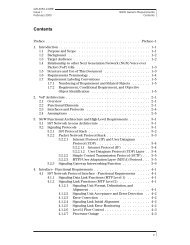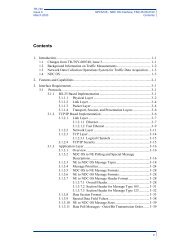Telcordia 2012 Generic Requirements (GR) Offers
Telcordia 2012 Generic Requirements (GR) Offers
Telcordia 2012 Generic Requirements (GR) Offers
Create successful ePaper yourself
Turn your PDF publications into a flip-book with our unique Google optimized e-Paper software.
SR-6002<br />
<strong>Telcordia</strong> <strong>Generic</strong> <strong>Requirements</strong>: <strong>2012</strong> <strong>Offers</strong> Issue 3, September 2011<br />
2. Add structural integrity and material design criteria to both walls and roofs to incorporate<br />
the applicable building code requirements and expected severe weather conditions for<br />
given sites. We anticipate developing a 2- or possibly 3-tier system of hut design to cover<br />
Standard-Moderate-Severe locales. The distinction between different locales would be<br />
based on the frequency of occurrences of hurricanes, tornados, lightning storms, floods,<br />
and so forth. New functional performance criteria to cover these circumstances would<br />
include resistance to<br />
2–20<br />
Hurricane = wind and rain stress<br />
Flood and water ingress<br />
Impact damage from flotsam (floods) or flying debris (wind storms).<br />
3. Design factors to facilitate expansion of huts as increasing demands for more equipment<br />
occur deeper into the local loop to support wireless, FTTx, and other broadband<br />
architectures. For example, standard sizes and mechanical design criteria will be added to<br />
allow cost-effective and modular expansion of a “standard hut” to become a “super-sized”<br />
hut, while maintaining structural integrity and mechanical robustness.<br />
4. Add a new section in <strong>GR</strong>-43 for “Huts that Serve Wireless Facilities” to explicitly elucidate<br />
specific additional or special criteria for wireless nodes and facilities to address the<br />
following:<br />
The increased need for Electromagnetic Compatibility (EMC) protection in the vicinity<br />
of cell tower sites - huts located beneath towers with the cable connections going up<br />
towers needing protection against lightning and Ground Potential Rise (GPR) incidents.<br />
Entry facilities - physical protection and Electromagnetic Interference (EMI)/EMC<br />
isolation<br />
Coordination with new <strong>GR</strong>-3171, <strong>Generic</strong> <strong>Requirements</strong> for OSP Network Elements<br />
Used in Wireless Networks - Physical Layer Criteria.<br />
The Value of Participation<br />
Since Issue 1 of <strong>GR</strong>-43 was released in October 1996, there is an even greater need to protect<br />
today’s expensive and sophisticated electronic equipment from the outdoor elements, and to<br />
address wireless-related requirements. As a participating company, you will be able to<br />
contribute changes to the existing requirements and define new, needed requirements. You<br />
will also have the opportunity to influence the best practices and performance test procedures<br />
and overall technical content of <strong>GR</strong>-43, Issue 2.<br />
<strong>Telcordia</strong> Invites Your Participation<br />
To proceed with this <strong>GR</strong>, it is expected that <strong>Telcordia</strong> will need at least five industry<br />
participants. While the project can proceed with fewer participants, the scope of work may<br />
need to be scaled back accordingly. Participating industry members will be apprised regularly<br />
of project status and change in scope. A preliminary conference call for all interested<br />
participants in this <strong>GR</strong> development project is scheduled for December 2011, at which time<br />
project details and status will be discussed. Please contact the project manager listed above<br />
for conference call details. If this date is not convenient, one-on-one discussions can be<br />
arranged with the project manager.





